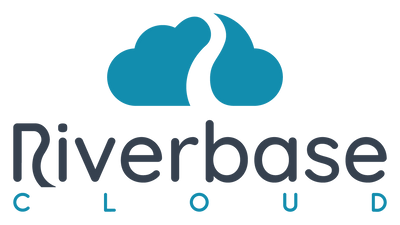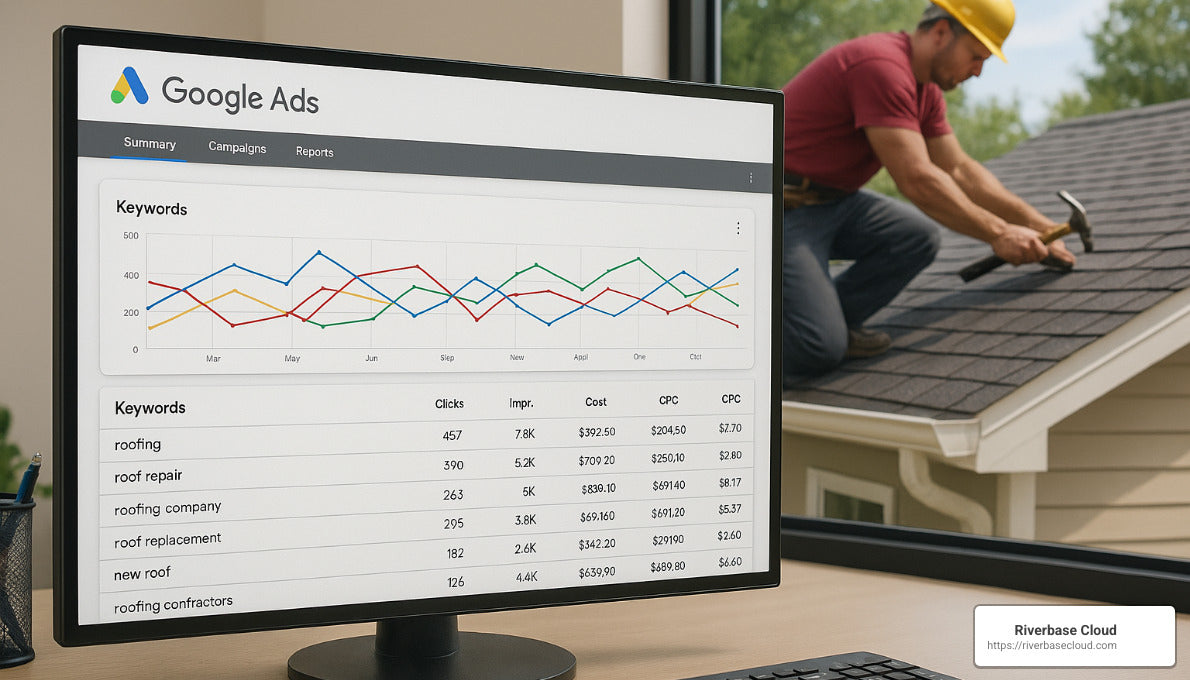Why Google Ads for Roofers is a Game-Changer
Google Ads for roofers provides an effective, scalable way for roofing businesses to gain immediate visibility with homeowners actively searching for roofing services. Here's a quick rundown of why it can make a huge difference for your roofing company:
- Targeted Local Visibility: Reach potential customers precisely when they need your services.
- Immediate Results: Quickly appear in search results without the wait associated with SEO.
- Cost-Effective: You only pay when someone clicks your ad.
- Measurable ROI: Track and measure the success of every dollar you spend.
As a roofer, you're competing in a crowded market. With thousands of contractors vying for attention, capturing the right leads can make or break your business. Google Ads helps you cut through the noise, connecting you directly with homeowners actively searching for roof repairs, installations, and replacements.
My name is Gary Gilkison; I've spent years specializing in digital marketing and PPC strategies, including managing successful Google Ads for roofers campaigns. At Riverbase Cloud, we use data-driven AI to help roofing businesses generate high-quality leads with measurable results.
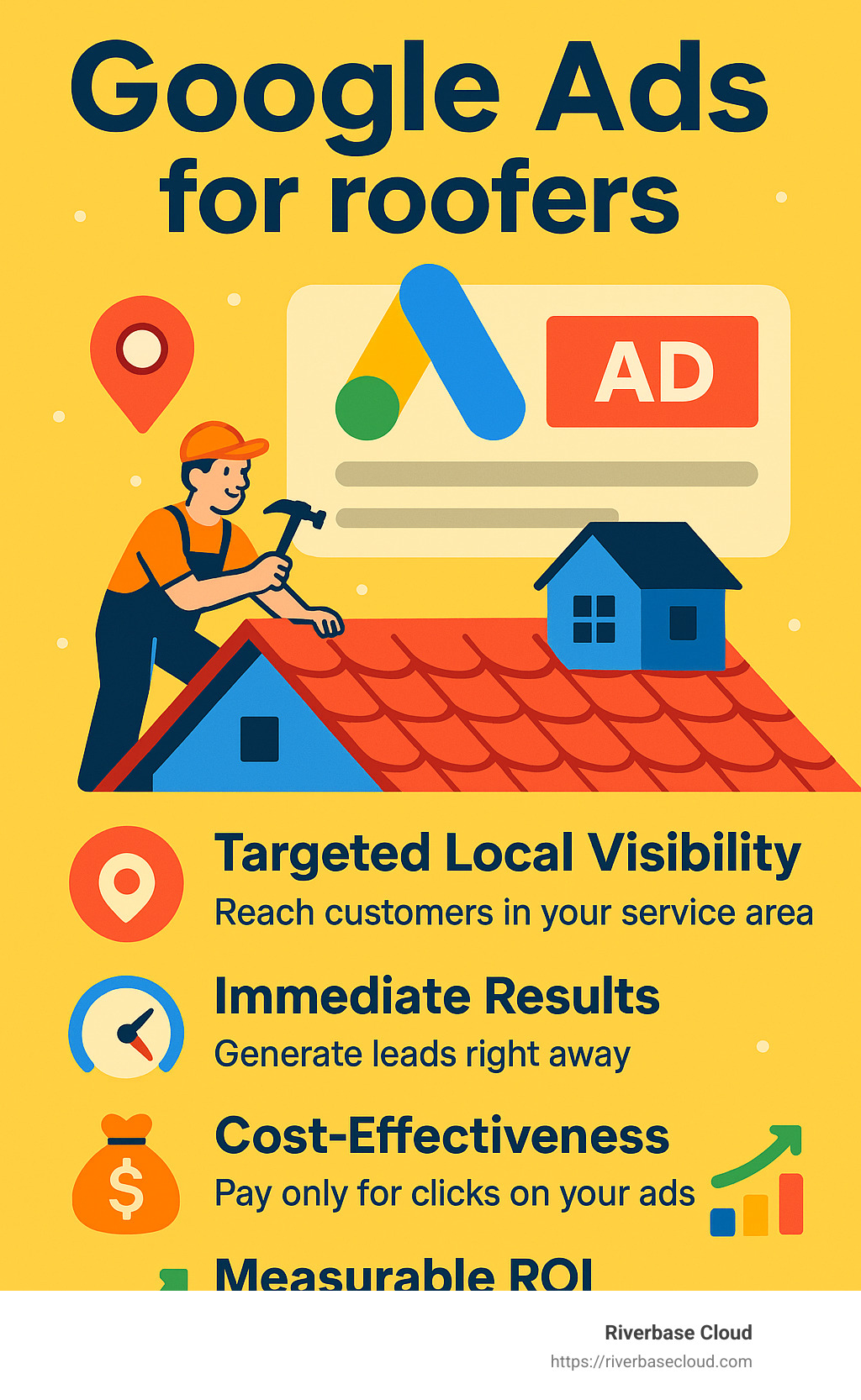
Google Ads for roofers terms explained:
- AI-driven SEO strategies
- Managed-AI ADS PPC
- Digital marketing plumbers
Understanding Google Ads for Roofers
The roofing industry in the United States is booming, valued at around $47 billion and projected to continue growing steadily each year. But with approximately 103,000 roofing contractors competing nationwide, standing out can feel like trying to wave from the back of a crowded stadium. Without the right strategy, your business can easily get lost in the shuffle. That's exactly where Google Ads for roofers step in.
Every second, Google processes over 99,000 searches, many from homeowners desperately needing roofing help. Whether they're dealing with emergency storm repairs, planning a roof replacement, or just looking for routine maintenance, these searches translate into real opportunities for your roofing business. Google Ads puts you front and center exactly when homeowners are actively searching for someone just like you.
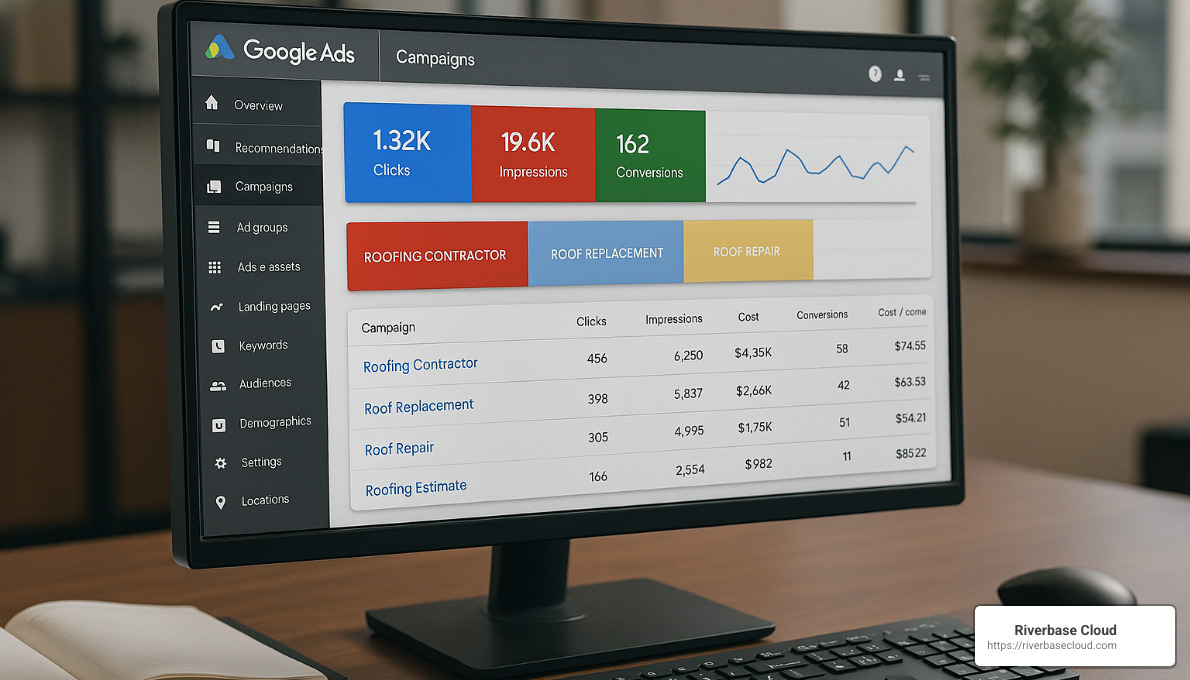
What is Google Ads?
Simply put, Google Ads is an online advertising platform that displays your ads to people searching for roofing services on Google and its partner sites. It uses a pay-per-click (PPC) model—so you only pay when someone actually clicks your ad and visits your website. Imagine it as handing out digital flyers, but instead of hoping the right person sees them, your ads appear directly to homeowners who are already looking for a roofer.
With Google Ads, your business doesn't need months to climb the search engine ranks organically. You gain immediate visibility, appearing right at the top of the search results whenever someone searches terms related to your services.
One roofer humorously summarized it best, "PPC actually means pay-per-click, but I like to think of it as pay-per-customer because I'm only spending when someone who's genuinely interested clicks through!"
To dive deeper into how PPC advertising works, you can visit the official Google Ads homepage or explore our own AI-driven ads services at Riverbase Cloud.
Why Google Ads is Effective for Roofers
The biggest reason Google Ads for roofers works so well boils down to one thing: intent. When someone is searching for "emergency roof repair near me," you can bet they're not casually window-shopping—they urgently need help. These high-intent leads make Google Ads particularly effective for roofing contractors because they're ready to act.
Industry research shows that ads on Google have a conversion rate approximately 50% higher than organic search results for roofing companies. The difference? Ads put your business right in front of homeowners who already know their roof has trouble spots and need solutions immediately.
Let's quickly compare Google Ads to some traditional advertising methods:
| Marketing Method | Targeting Capability | Speed to Market | Cost Efficiency | Measurability | Flexibility |
|---|---|---|---|---|---|
| Google Ads | High (based on search intent) | Immediate | Pay per click | Highly measurable | Easily adjustable |
| Newspaper Ads | Low (broad audience) | Days to weeks | Fixed cost | Difficult to measure | Limited flexibility |
| Billboard Advertising | Very low (general public) | Weeks | High fixed cost | Nearly impossible to measure | Very limited |
| Direct Mail | Medium (by zip code) | Weeks | Cost per mailer | Moderate | Limited |
| Radio/TV | Low (broad audience) | Days to weeks | High fixed cost | Difficult to measure | Limited |
Clearly, when it comes to targeting, speed, flexibility, and measurability, Google Ads is the winner. In fact, one roofing business saw a massive 150% rise in leads within just two months simply by focusing on localized keywords and responding quickly to ad inquiries.
Another roofer boosted their conversion rate by 30% by setting up a smart remarketing campaign—this strategy re-engaged past website visitors, enticing them back at the exact moment they decided it was finally time to fix their leaky roof.
Google Ads gives roofers like you a powerful way to connect directly with homeowners who genuinely need your services. It allows you to see exactly how your marketing dollars are performing, giving you the confidence to invest wisely and watch your business grow.
Setting Up Your Google Ads for Roofers Campaign
Let's face it – setting up your first Google Ads for roofers campaign can feel a bit intimidating. But don't worry! I'm going to walk you through this step-by-step, just like I would if we were sitting at your kitchen table with a couple of coffees.
The good news? Once you understand the basics, you'll see it's actually quite straightforward. And the even better news? The return on investment can be tremendous when done right.
Choosing the Right Campaign Type
When you first log into Google Ads, you'll see several campaign options. For roofing contractors, three main types stand out:
Search Network Campaigns are your bread and butter. These are the text ads that appear when homeowners search for phrases like "roof leak repair" or "roofing company near me." For most roofers just getting started with Google Ads, this should be your primary focus. They deliver high-intent leads – folks who are actively looking for exactly what you offer.
Google Local Services Ads (LSA) are the premium spots at the very top of search results. They show up with that trusty "Google Guaranteed" badge, which can be worth its weight in gold for local service businesses. Unlike regular ads, you pay per lead rather than per click. Many of our most successful roofing clients use both Search ads and LSAs together for maximum visibility.
Display Network Campaigns show banner-style ads across thousands of websites. While not usually the best starting point, they're excellent for remarketing – keeping your roofing company in front of people who've already visited your website but haven't yet called.
One of our roofing clients in Colorado put it perfectly: "I started with just Search ads, but adding Local Services Ads was like turning on a second faucet of leads. Now people see us at both the top and middle of the search results."
For a deeper dive into campaign types, check out Understanding Google Ads Basics.
Defining Your Target Audience
This is where Google Ads for roofers really shines compared to traditional advertising. Instead of paying to reach everyone (and hoping the right people see your message), you can zero in on exactly who needs your services.
Geo-targeting is absolutely essential for roofing companies. You'll want to limit your ads to appear only in areas where you actually provide service. You can target by specific cities, zip codes, or even draw a custom radius around your business location (like "within 25 miles of downtown").
This precision targeting means you won't waste money on clicks from homeowners who live too far away. The data backs this up too – 76% of people who search for a local business on their smartphone visit that business within 24 hours.
Demographics might seem less important for emergency services like roofing, but they can still help refine your campaigns. You might focus on homeowners rather than renters, certain income brackets that match your service pricing, or age groups most likely to own homes in your area.
Time-targeting is often overlooked but can make a big difference. Consider when you want your ads to appear:
- During business hours when your team can answer calls
- Evenings when homeowners are researching solutions after work
- Weekends when people have time to think about home improvement projects
- Increased budgets during storm season in your area
A roofing contractor we work with in Florida saw a 32% improvement in lead quality simply by pausing his ads during hours when his office was closed, then resuming them when his team was fresh and ready to respond quickly.
"The beauty of Google Ads," he told me, "is that I'm not paying to advertise when my team can't provide great service. We increased our budget during business hours and stopped wasting money on midnight clicks that turned into voicemails."
At Riverbase Cloud, we've helped dozens of roofing companies set up their Google Ads campaigns for maximum impact. Our approach combines AI-driven optimization with human oversight – ensuring your ads reach the right people at the right time, without wasting your hard-earned marketing dollars.
The goal isn't just to get clicks – it's to get the phone ringing with qualified leads who need exactly what you offer. A properly set up campaign is the foundation for making that happen consistently.
Keyword Research for Roofing Services
Effective keyword research is the cornerstone of any successful Google Ads for roofers campaign. Choosing the right keywords helps you connect directly with homeowners actively looking for your services. Pick the wrong ones, however, and you'll burn through your budget faster than a roof during storm season—without seeing the results you need.
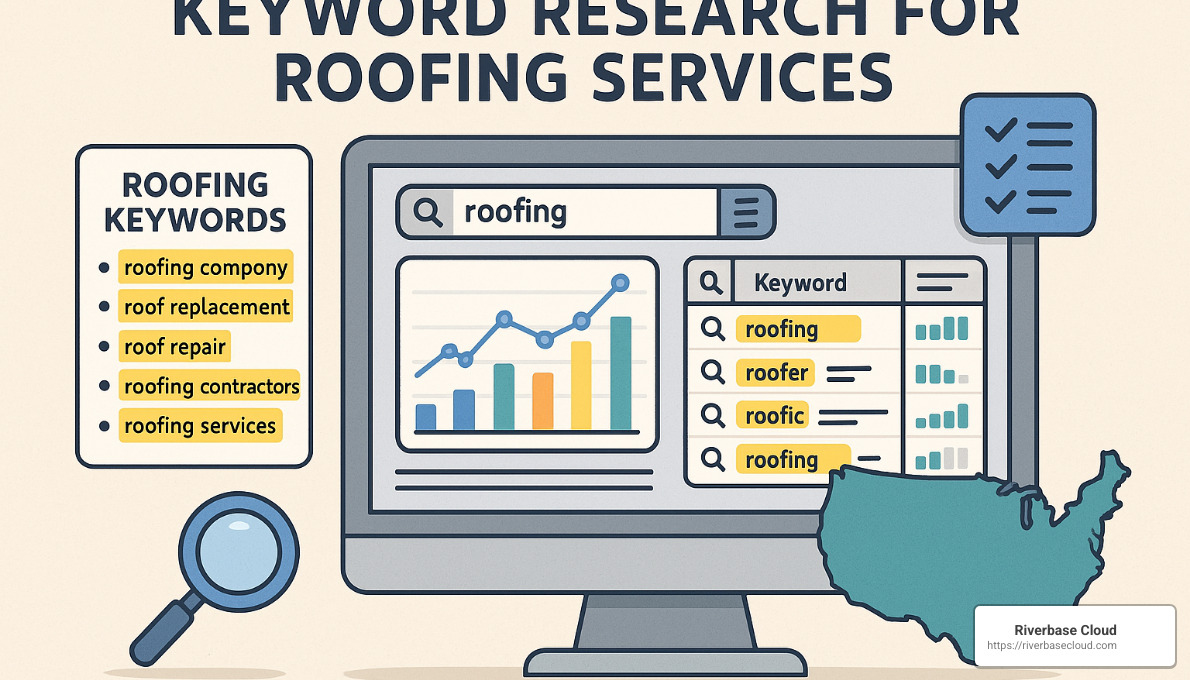
Selecting Effective Keywords
When you're selecting keywords, think like a homeowner who's ready to hire—not just someone casually browsing. What words do they use when they're serious about finding roofing help?
Start by targeting service-specific keywords. These are clear and direct terms homeowners use when they're ready to take action. Examples include phrases like "roof repair in [city name]", "emergency roof leak repair", "roof replacement cost," and "metal roofing installation."
Also, consider problem-based keywords, which are searches from homeowners describing their roofing issues. These might include phrases such as "roof leaking after rain," "storm damage roof repair," or "hail damage roof inspection." These keywords often signal urgency—someone needs help, and they need it quickly!
Additionally, many homeowners simply look for local services using location-based keywords, like "roofers near me," "best roofing company in [city]," or "local roof repair contractors." These searches usually come from homeowners ready to pick up the phone and book your services.
Don't forget to sprinkle in plenty of long-tail keywords. These are longer, more precise phrases typically searched by people who know exactly what they need and are closer to hiring. Think along the lines of "affordable metal roof installation in [city]," "emergency roof repair same day service," or "licensed and insured roof replacement contractors." While these terms might have fewer searches than broader keywords, they usually convert better and cost less per click.
To find out exactly which keywords to choose, try Google's free tool, the Google Keyword Planner. It helps you see how many people search for specific keywords each month, how competitive those keywords are, and even suggests other related keywords you might not have thought of.
One roofer explained it simply: "Instead of guessing, we looked at our past campaigns and service records. Turns out certain keywords like 'emergency roof leak repair' drove the most calls. So we doubled down on those, and our leads skyrocketed!"
Choosing the right keywords isn't about guesswork—it's about knowing your customers, using powerful tools like the Keyword Planner, and learning from your past successes.
Implementing Negative Keywords
Just as important as choosing the right keywords is making sure you're not paying for irrelevant clicks. This is where negative keywords step up to save your budget.
Negative keywords tell Google when NOT to show your ads. They prevent you from showing up in searches unrelated to your roofing services (and wasting your clicks on the wrong audience).
Common negative keywords for roofing companies often include:
- DIY and instructional terms like "DIY," "how to," "tutorial," and "guide." These folks are looking for instructions, not professional services.
- Job-seeking terms such as "jobs," "careers," "employment," and "hiring." Unless you're hiring, these searches won't help bring in new customers.
- Educational terms including "course," "certification," "training," and "school." You're not a roofing academy—you're a roofing company!
- Free and discount seekers, words like "free," "cheap," "discount," and "wholesale." These clicks often come from people not ready to pay for quality service.
- Competitor names, unless you're specifically trying to target people researching your competitors.
One seasoned roofing business owner shared their experience: "We got serious about negative keywords, and it cut down our wasted clicks dramatically. Our cost per lead dropped nearly 30%."
To really fine-tune your negative keywords, regularly check your Google Ads Search Terms report. This simple habit helps you see exactly what phrases triggered your ads. Spot an irrelevant search? Add it to your negative keywords right away.
Implementing negative keywords isn't glamorous, but it's one of the smartest things you'll do for your budget. After all, you want every dollar you spend on Google Ads for roofers to count.
Structuring Your Google Ads Campaign for Success
When it comes to Google Ads for roofers, getting the structure right can truly make or break your campaign. Think of your Google Ads campaign like a well-organized toolbox: everything has its own spot, and you can quickly find exactly what you need. A clear structure improves your Quality Score, lowers your cost per click, and boosts your visibility to potential customers.
Let's explore exactly how you can set up your roofing ads campaign for maximum success.
Organizing Ad Groups by Roofing Services
One common mistake roofers make is throwing all their keywords into a single ad group. Don't be that person! Instead, create individual ad groups for each type of roofing service you offer. This approach helps you keep your ads highly relevant to what homeowners are actually searching for, improving both your ad performance and Quality Score.
For instance, your roofing services campaign might look like this:
Roof Repair: Your keywords here might include "roof repair," "fix roof leak," or "roof damage repair." Ads in this group should speak directly to homeowners concerned about leaks or storm damage.
Roof Replacement: In this ad group, you'll include keywords like "roof replacement," "new roof installation," or "roof tear-off." The ads will emphasize your expertise in replacing old or damaged roofs and your quality craftsmanship.
Emergency Roofing: Emergencies happen—roofs don't exactly wait for regular business hours to spring a leak! For this ad group, use terms like "emergency roof repair," "24/7 roof service," or "roof leak emergency." These ads should highlight your rapid response times and availability around the clock.
Specialty Roofing: If you specialize in certain materials such as metal, slate, or tile, create an ad group specifically for them. Keywords here might include "metal roofing," "slate roof installation," or "tile roofing." Focus your ads on your exceptional skills with specialty materials.
Here's a quick visual to help you picture it clearly:
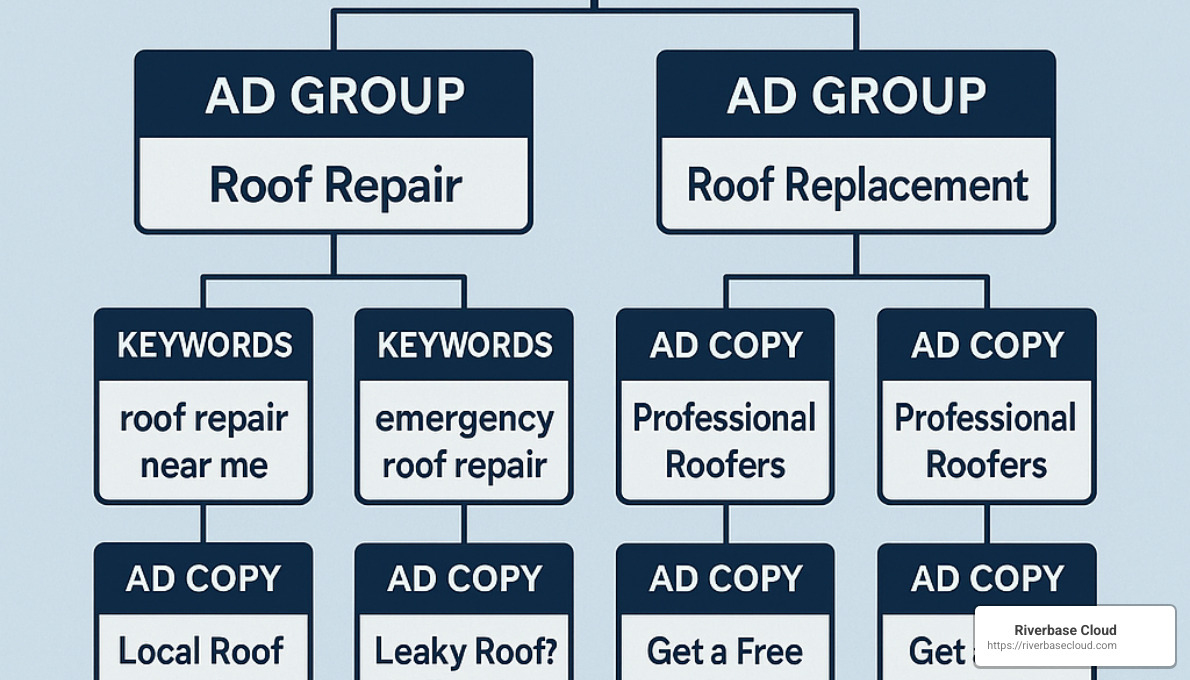
By splitting your campaign into these clear ad groups, homeowners searching for "emergency roof repair" won't just see generic ads—they'll see an ad directly addressing their urgent needs. As a marketing professional once wisely explained: "Organize your ads into themed ad groups to boost their relevancy and effectiveness. And don't forget to set up conversion tracking to see exactly how homeowners are interacting with your website."
Optimizing Bids and Budgets
Managing bids and budgets effectively is just as important as structuring your ads. After all, no roofer wants to waste their hard-earned money on ineffective ads! To start, consider using manual bidding. This method allows you to set precise cost-per-click (CPC) bids custom to each roofing service you advertise.
With manual bidding, you have full control. You can increase bids for keywords that consistently bring you valuable leads or decrease bids for keywords that aren't performing well. Over time, this approach helps you fine-tune your campaign, ensuring you get the most bang for every buck spent.
Next, let's talk about budget allocation. Your Google Ads budget shouldn't just be a random number; it should be strategic. Allocate more of your budget to services that generate the most revenue or leads. Seasonal factors are important too—storm season often brings more urgent repairs, so you might increase your spending during this period.
Industry experts recommend that roofing companies dedicate about 10% of their total revenue toward marketing. Let's say your company earns around $2.5 million annually—that would mean approximately $20,000 per month for all marketing efforts, with Google Ads as a significant part of that mix.
Considering that a single roofing job typically brings in between $5,000 and $12,000, landing even just a few successful projects per month through your Google Ads campaign can easily pay for the entire campaign itself—making Google Ads for roofers one of the smartest investments you can make.
Building your campaign structure carefully and managing bids strategically will not only maximize your return on investment, but also help your roofing business stand out from the competition. And remember, if the thought of juggling campaigns, ad groups, and budgets is overwhelming, our team at Riverbase Cloud is always here to help with Managed-AI ads solutions—keeping your digital marketing seamless and stress-free.
Creating Compelling Ad Copy for Roofers
Your Google Ads will bring potential customers right to your doorstep, but the ad copy is what convinces them to knock on your door instead of your competitor's. Think of your ad copy as a friendly handshake—it should immediately build trust, make a great first impression, and clearly show what makes your roofing business special.
Good ad copy isn't just about being clever or catchy (although a little creativity never hurts!). It's about directly connecting with your customers by addressing their specific problems, offering clear solutions, and guiding them towards taking positive action.
Best Practices for Ad Copy
When crafting ad copy for your Google Ads for roofers campaign, there are a few straightforward guidelines that'll make sure you're speaking your customer's language and engaging them effectively.
First, always include your main keywords in headlines. This tells your potential customers they’ve found exactly what they're looking for, and boosts your ad's Quality Score—which means you get more visibility at a lower cost. Examples of effective, keyword-rich headlines include: "Emergency Roof Repair in [City]," "Professional Roof Replacement Services," and "Local Roof Leak Repair - Same Day Service."
Next, always address your customer's pain points head-on. Customers searching for roofers often feel stressed, worried, or frustrated. Speak directly to these emotions with phrases like: "Leaky Roof? We Fix It Fast," "Storm Damage? Free Roof Inspection," or "Worried About Roof Costs? Free Estimates." This approach instantly makes your ad relevant and relatable.
Don't forget to clearly showcase your unique selling propositions (USPs). What makes your business stand apart? Are you experienced, highly rated, fully licensed? Highlight standout points like "25+ Years of Roofing Experience," "Licensed, Bonded & Insured Roofers," or "5-Star Rated Local Roofing Company." These details reassure customers they're making the right choice by clicking your ad.
Lastly, always feature a strong and clear call-to-action (CTA). People need to know exactly what to do next—don't leave them guessing! Examples include: "Call Now for Same-Day Service," "Schedule Your Free Inspection Today," or "Get Your Free Quote in Minutes."
Marketing experts say: "Create short, catchy headlines using keywords, numbers, and persuasive words like 'free' or 'now', and write concise descriptions that include a clear call-to-action and specific offers to drive clicks and conversions."
Remember to regularly test different versions of your ads. Google Ads makes it easy to run multiple ad variations within each ad group. Over time, you'll find the wording, offers, and CTAs that resonate best with your audience—saving money and driving more leads in the process.
Utilizing Ad Extensions
Ad extensions are like bonus features for your Google Ads for roofers campaigns. They allow you to add extra information, helping your ads stand out and giving potential customers even more reasons to click.
A few highly effective extensions for roofing businesses include Sitelink Extensions, which provide users with direct links to important pages like "Free Roof Inspection," "Emergency Repairs," "Financing Options," or "Our Guarantees."
Another great choice is Callout Extensions, short phrases that highlight your top offers or unique competitive advantages. Think "24/7 Emergency Service," "Licensed & Insured," "Free Estimates," or even "Lifetime Warranty"—all powerful statements that build trust and credibility at a glance.
Since roofing customers often look for local contractors, Location Extensions can visibly display your address, creating immediate trust and helping homeowners choose a reliable, nearby business.
Roofing issues are often urgent, so don't underestimate the value of Call Extensions. These add a clickable phone number directly on your ads, allowing people to call you immediately—perfect for emergency roofing situations.
Lastly, consider Structured Snippet Extensions, which allow you to easily showcase the different roofing services and materials you offer: "Services: Repairs, Replacements, Inspections, Maintenance," or "Roofing Types: Asphalt, Metal, Tile, Flat."
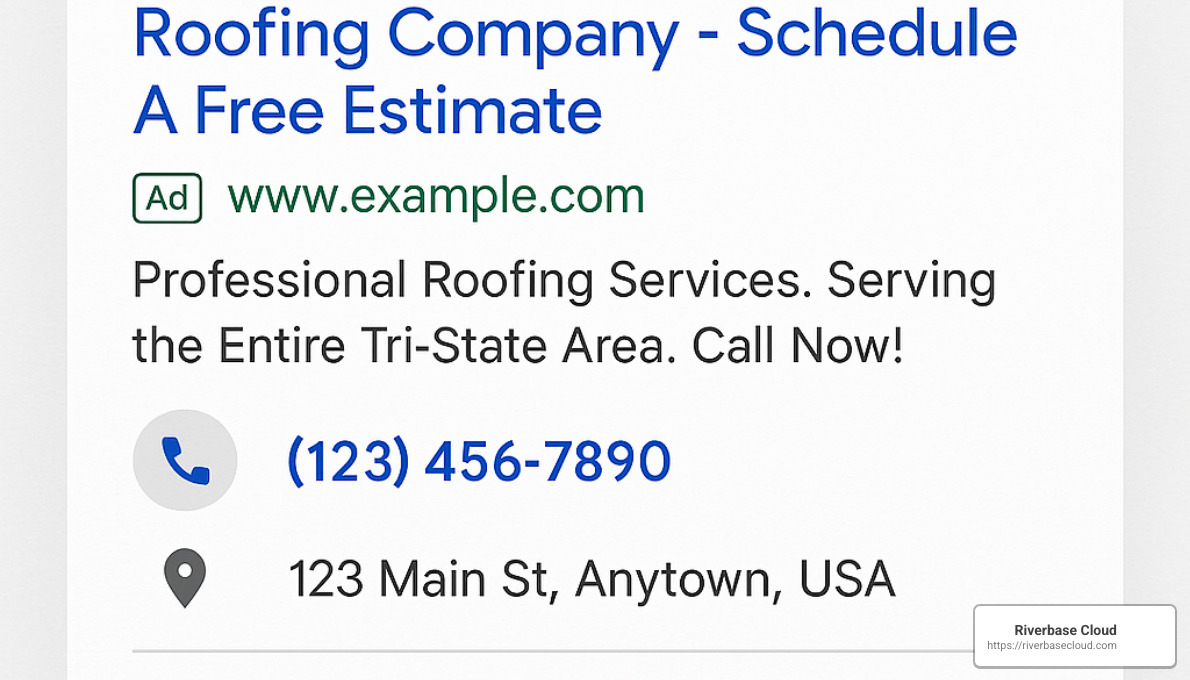
Experts agree that using every available ad extension and crafting compelling ads that highlight trust factors significantly improves your click-through rates and conversions. To learn more about extensions and how to implement them in your campaigns, you can visit Google Ads Extensions.
Your Google Ads should feel welcoming, professional, and reassuring—the type of ads that convince homeowners they've found the roofing company they've been searching for. Keep testing, optimizing, and tweaking your ad copy and extensions, and you'll soon be turning clicks into loyal customers.
Optimizing Landing Pages to Increase Conversions
Your landing page is where the magic truly happens—it's the point where your expertly crafted Google Ads for roofers campaigns transform curious visitors into real leads. Even the most compelling ad won't deliver results if your landing page isn't consistently optimized and aligned with your messaging.
Here's how to ensure your landing pages deliver the conversions your roofing business deserves.
Aligning Landing Pages with Ads
Imagine clicking on a roofing ad promising a "Free Roof Inspection," only to land on a generic homepage with no mention of the offer. Frustrating, right? That's why message match matters so much in PPC advertising. Your landing page should seamlessly continue the conversation your ad starts.
Consistency in messaging is key. If your ad highlights emergency roof repair services with rapid response times, your landing page should prominently echo that promise. Use headlines that directly match your ad's message to reassure visitors they've arrived at the right place.
Visual consistency matters too. If your ad features a friendly roofer smiling atop a roof, include similar imagery on your landing page. Consistent visuals help build trust and convey professionalism—a big plus when homeowners are deciding whom to trust with their roofing needs.
Don't forget to fulfill the promise your ad made. If you offered a free roof inspection or a quick quote, make it immediately clear how visitors can claim their offer. A clear call-to-action like "Schedule Your Free Roof Inspection Now!" or "Get Your Quote Today!" removes confusion and guides visitors smoothly toward conversion.
To build trust even further, include clear trust signals on your landing pages. Customer testimonials highlighting how you've helped local homeowners are a powerful way to show credibility. You can also showcase industry certifications, licensing details, insurance information, guarantees, and warranties. Before-and-after photos of projects you've completed add another layer of reassurance to your potential customers.
As one successful roofer shared: "Making sure our landing pages perfectly matched our ads built instant trust with homeowners—and boosted our conversions by 35%!"
Improving Conversion Rates
Once you've aligned your landing pages with your ads, it's time to fine-tune your page to boost conversions even further. Conversion rate optimization doesn't have to be complicated—just keep a few simple, effective tips in mind.
One of the easiest wins is to simplify your forms. Long, complicated forms make visitors hesitate. Keep things easy—ask only for the essential info you really need, such as name, phone, email, and the basics about their roofing issue. Every additional field increases the likelihood that visitors bounce without submitting their info. If your roofing projects tend to involve complex requests, consider using a short multi-step form to avoid overwhelming visitors all at once.
Another game-changing technique is to feature authentic testimonials from satisfied customers. A glowing testimonial like "Riverbase Roofing rescued us when our roof leaked after a bad storm—highly recommend!" adds a real human touch. Including photos of the homeowners (with permission, of course!) or referencing local neighborhoods you regularly serve helps build even more trust.
Don't underestimate the power of fast page load times. Nobody likes waiting around, especially when their roof is leaking! Compress your images, streamline your website's code, and consider using a content delivery network (CDN) to speed things up. Google's PageSpeed Insights can quickly show you how your landing pages measure up and provide tips to boost performance.
Finally—and this is critical—make sure your landing pages are optimized for mobile devices. With so many homeowners searching on their phones, you can't afford clunky mobile experiences. Use large, easy-to-tap buttons, clear text, click-to-call functionality, and streamlined navigation to make your mobile landing pages intuitive and user-friendly.
One roofing company increased its conversion rate by an impressive 40% simply by making their landing pages mobile-friendly and cutting their form fields from 7 to 4. Small changes, big results!
By aligning your landing page experience with your ads, keeping forms simple, showcasing authentic customer reviews, improving page speed, and focusing on mobile optimization, you'll ensure your Google Ads for roofers campaigns consistently deliver the quality leads your roofing business needs to thrive.
Budgeting and Managing Your Google Ads Spend
Managing your budget effectively is key to getting the most out of your Google Ads for roofers investment. Even a modest budget, handled wisely, can lead to significant gains for your roofing business.
When you approach budgeting thoughtfully, every dollar you spend can translate into real results—more leads, more roofing jobs, and higher revenue for your company.
Setting Your Daily and Monthly Budgets
Determining how much to spend on your Google Ads campaign can feel overwhelming, but let's break it down into simple steps.
First, consider your average cost per click (CPC). Roofing keywords usually range between $5 and $30 per click, depending on your local competition and geographic area. Major cities typically have higher CPCs due to stronger competition, while smaller towns or rural areas might cost less.
Next, think about how many clicks you'd like to generate each month. For example, if your average CPC is around $10 and you'd like 100 website visitors per month, your monthly budget should be around $1,000.
But clicks alone don't pay the bills—you'll want to consider your conversion rates. On average, roofing campaigns see a conversion rate between 5% and 10%. This means if you have 100 clicks to your site, you might get around 10 solid leads each month.
Now, not every lead becomes a customer—typically around 30% of roofing leads convert into paying jobs. So, from those 10 leads per month, you could realistically expect about 3 new roofing projects.
Finally, look at your average job value. Let's say your average roofing job is around $8,000. Those 3 new customers generated through your $1,000 monthly ad spend could produce around $24,000 in revenue—a fantastic return on investment!
To help visualize different scenarios, here's a quick table comparing a few budget examples:
| Monthly Budget | Avg. CPC | Monthly Clicks | Conv. Rate | Monthly Leads | Lead-to-Customer | New Customers | Avg. Job Value | Monthly Revenue | ROI |
|---|---|---|---|---|---|---|---|---|---|
| $1,000 | $10 | 100 | 10% | 10 | 30% | 3 | $8,000 | $24,000 | 2,300% |
| $2,500 | $10 | 250 | 10% | 25 | 30% | 7.5 | $8,000 | $60,000 | 2,300% |
| $5,000 | $10 | 500 | 10% | 50 | 30% | 15 | $8,000 | $120,000 | 2,300% |
As you can see, even small adjustments in your spend can significantly boost your results. One roofing marketing expert recommends that businesses generating over a million dollars annually set aside at least $2,500 per month for Google Ads, with many successful contractors investing between $3,000 and $5,000 monthly. But don't worry—start small, see positive outcomes, and then grow your budget naturally as you gain confidence.
The great thing about Google Ads is flexibility—you can set daily budgets and easily adjust them based on what's working best. This way, you're never locked into a fixed expense.
Monitoring and Adjusting Bids
Once your Google Ads for roofers campaign is live, your work isn't finished—you'll want to regularly monitor its performance and tweak your bids to get the best results.
Google Ads offers various bidding strategies. Many roofing businesses start with Improved CPC (Improved Cost Per Click) because it blends manual control with Google's AI-powered optimization. This strategy lets you set your own bids but also allows Google's algorithms to automatically adjust them up or down slightly based on the likelihood of conversion.
Other bidding methods include Maximize Clicks, which focuses on getting you the most clicks possible within your budget, Target CPA (Cost Per Acquisition), which aims for a specific cost per lead, and Target ROAS (Return On Ad Spend), which prioritizes your desired return on investment. However, for roofers just starting out, Improved CPC usually provides the best balance between control and efficiency.
When adjusting bids, the key is focusing not just on your cost-per-click, but on your overall cost per lead or acquisition. This means you'll want to raise bids on keywords driving high-quality leads and lower bids on keywords that get clicks without converting. If you notice certain keywords consistently draining your budget without results, don't hesitate to pause or remove them entirely.
One successful roofing contractor shared how regularly reviewing and updating bids based on real-world data helped them lower their cost per lead by nearly 40%. That's a huge saving while still maintaining steady leads!
At first, you'll want to keep a close eye on your campaign daily—at least during the first few weeks. Once your campaign stabilizes, you can move to weekly check-ins. The goal is steady, thoughtful improvements rather than quick reactions to short-term fluctuations.
When you budget and manage your Google Ads spend effectively, you'll quickly see how even a small investment can yield powerful returns—turning clicks into customers and helping your roofing business thrive.
Tracking and Measuring ROI of Your Google Ads Campaign
You've put a lot of effort into setting up your Google Ads for roofers campaign—but how do you know it's working? Without proper tracking and measurement, you're really just guessing (and we'd rather leave guessing to weather forecasts, not your marketing!).
Accurately tracking your results is essential. It helps you understand what's working, what's not, and how you can squeeze every last bit of value from your advertising dollars.
Setting Up Conversion Tracking
First things first—what exactly counts as a "conversion"? For roofing businesses, conversions typically include phone calls (usually the #1 priority), contact form submissions, appointment bookings, and even live chat interactions (if you're using one).
Once you've defined what actions matter most for your business, the next step is to set up Google's conversion tracking. Thankfully, this isn't complicated! Google provides simple snippets of code that you add to your website to measure these valuable customer interactions.
For example, to track form submissions, add Google's conversion tracking code to your "thank you" page—the page visitors see after submitting the form. This signals to Google that the visitor successfully converted. Similarly, you can monitor specific button clicks or page visits by integrating conversion codes with Google Tag Manager.
Since phone calls are usually gold for roofing businesses, you'll definitely want to track those closely. Google Ads includes call extensions with built-in call tracking, letting you see exactly how many calls your ads generate. If you want even deeper insights, you can also consider a dedicated call tracking service. This can track not just calls coming directly from ads, but also calls coming from visitors on your website—giving you the full picture of your campaign's impact.
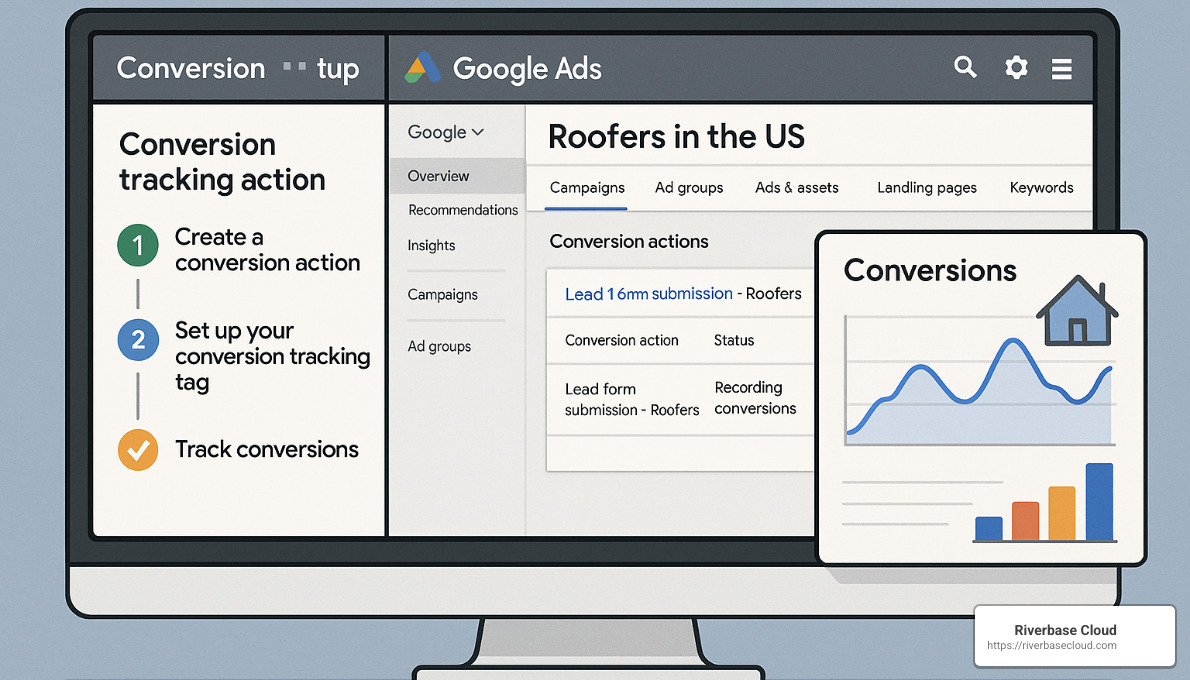
Analyzing Campaign Performance
Once you've set up conversion tracking, it's time to dive into the metrics. Don't worry; you don't need to be a math whiz or analytics guru. You just need to keep an eye on a few key indicators to understand your campaign's success.
Start with Click-Through Rate (CTR)—this tells you what percentage of people who saw your ad actually clicked it. For roofing ads, a good CTR usually ranges from 3-5%. If your CTR is too low, it might mean your ad copy isn't resonating, and it's time to freshen things up.
Next, look at your Conversion Rate, which shows the percentage of clicks turning into leads—typically around 8-12% for roofing companies. Let's say you had 100 clicks and 10 people submitted your form or called—that's a solid 10% conversion rate.
Another important metric is Cost Per Conversion, or how much you're spending to get each lead. Ideally, this cost should be much lower than the profits you make from each roofing job. If your cost per conversion is too high, consider adjusting bids, refining keywords, or improving your landing pages.
Of course, the ultimate measure of success is your Return on Ad Spend (ROAS). This simply means how much money you're making in relation to what you're spending. For roofing companies, a strong ROAS is usually between 400-800%. In other words, if you put $1 into your campaign and it generates $5 revenue, that's a 500% ROAS—definitely worth celebrating (maybe with a nice coffee break!).
Finally, don't ignore your Google's Quality Score. This is Google's rating of your keywords and ads based on relevance and landing page quality. High scores typically mean lower costs and better ad positions, which can boost your overall profitability. If your quality scores are low, take a closer look at your keywords, ad copy, and landing pages to improve relevance.
By regularly monitoring and analyzing these metrics, you can make smarter decisions. You'll quickly see what's driving leads and where you can improve. Maybe certain keywords are knocking it out of the park—great, raise your bids and get even more traffic! Or maybe certain ads just aren't performing—pause and tweak them to improve results.
One roofing company we worked with at Riverbase Cloud saw incredible results by doing exactly this. Through ongoing monitoring and adjustments based on their key metrics (CTR, conversion rate, cost per conversion, ROI), they reduced their cost per lead by 70% while increasing lead volume by 35%. Pretty impressive, right?
Remember: the beauty of Google Ads for roofers is that you're never locked in. You can continuously refine and optimize campaigns based on real-time data. And when you partner with experts like us at Riverbase Cloud, you get the added advantage of AI-driven insights combined with human expertise—making sure your campaigns are working hard for your business every step of the way.
Common Mistakes to Avoid in Google Ads for Roofers
Even seasoned professionals can trip up when managing Google Ads for roofers campaigns (yes, even us!). But don’t worry—being aware of these common pitfalls can save you headaches, time, and money down the road. Let's explore some frequent mistakes, so you can confidently steer clear of them and keep your campaign running smoothly.
Overlooking Negative Keywords
One of the biggest (and most costly) mistakes roofers make with Google Ads is not fully utilizing negative keywords. Negative keywords are terms you add to your campaign to stop your ads from appearing for irrelevant searches. Without them, you can quickly drain your budget on clicks from people who aren't actually looking to hire a roofer.
For instance, imagine someone searches for "how to fix roof leak DIY." Chances are, they're looking for step-by-step tutorials and aren't in the market for hiring a roofing company. By adding terms like "DIY," "how to," "tutorial," and similar phrases to your negative keywords, you avoid spending money on these non-converting clicks.
Another typical oversight is allowing ads to show up for job seekers searching "roofing jobs," "roofer salary," or "roofing careers." While it's great you're hiring, these searches won't generate customers. By excluding employment-related terms, you focus your ad spend solely on potential customers.
Competitor names are another area to watch. Unless you're targeting people specifically searching for competitors (which can be tricky and expensive), it's best to exclude rival business names from your campaign. Otherwise, you'll potentially pay for clicks from curious visitors who aren't seriously considering your company.
Lastly—and perhaps the most important—regularly review your Search Terms report within Google Ads. Doing this helps you spot irrelevant searches triggering your ads, allowing you to continuously refine your negative keyword list and protect your budget. As one PPC expert advises, "Regularly reviewing your search terms to identify irrelevant searches triggering your ads is a must-do practice to avoid wasting money."
Not Tracking Conversions
Another critical mistake that can really hamstring your Google Ads for roofers campaign is failing to set up proper conversion tracking. Without reliable conversion data, you're essentially driving blindfolded—sure, you're moving somewhere, but you have no idea what's actually working or where your money is going.
Proper conversion tracking lets you clearly see which keywords and ads are generating phone calls, form submissions, and other valuable customer interactions. Without this, it's impossible to accurately calculate your real cost per lead or understand your campaign's true return on investment (ROI).
One roofer shared their personal experience, saying, "When we first started with Google Ads, we only tracked clicks—not conversions. It wasn't until we implemented proper call tracking and form submission tracking that we realized nearly 80% of our leads came from just 20% of our keywords. Knowing this helped us reallocate our budget to these winning keywords, effectively doubling our leads without increasing our ad spend."
That's the beauty of conversion tracking. It provides clear, actionable data that helps you adjust your strategy, focus your dollars on what's working, and continually improve your results.
Other Common Mistakes to Watch Out For
There are several other pitfalls that roofers frequently encounter with Google Ads. Here are some key issues to stay mindful of:
Using Only Broad Match Keywords: While broad match keywords can generate lots of clicks, they're often irrelevant. Starting with exact match or phrase match keywords helps you narrow your targeting and get higher-quality clicks from potential customers.
Directing Traffic to Your Homepage: Sending users straight to your homepage is like bringing them to the front of your store but not showing them the items they're interested in. Instead, create dedicated landing pages for each roofing service, ensuring visitors see relevant offers and messaging right away.
Ignoring Mobile Users: A significant number of roofing-related searches—especially emergency repairs—happen on mobile devices. If your landing pages aren't mobile-friendly, you risk losing potential customers frustrated by slow loading speeds or hard-to-steer pages.
'Setting and Forgetting' Your Ads: Google Ads isn’t a "set it and forget it" tool. Successful campaigns require ongoing monitoring, regular adjustments, and continuous optimization. Regularly checking your campaign performance and making data-driven adjustments is key to long-term success.
Focusing Too Much on Ad Position Rather Than Profitability: Everyone wants top placement, but always chasing position #1 could burn your budget fast. Carefully track your ROI—sometimes positions 2 or 3 yield a better overall return, especially if the cost per click for the top spot is significantly higher.
Avoiding these common mistakes helps ensure your Google Ads for roofers campaign runs effectively, efficiently, and profitably. By staying vigilant, regularly reviewing your data, and continually optimizing your campaigns, you’ll maximize your leads, minimize wasted budget, and stay ahead in a competitive roofing market.
Frequently Asked Questions about Google Ads for Roofers
How much does it cost to run Google Ads for a roofing business?
One of the most common questions roofers have when starting with Google Ads for roofers is, "how much will this cost me?" The short answer is—it depends. But let's unpack this a bit more clearly.
Most roofing companies typically spend between $1,000 and $5,000 per month on Google Ads. As a general rule of thumb, marketing experts suggest allocating around 10% of your overall revenue towards marketing, with Google Ads representing just one slice of that marketing pie.
Each click on roofing-related keywords typically costs between $5 and $30, depending on factors like your geographic location and how fierce the competition is. Roofers in big cities usually see higher costs per click compared to those in smaller towns.
For established roofing contractors, the sweet spot to get meaningful results often starts around $2,500 per month. Many of the most successful roofing companies ramp up spending into the $3,000 to $5,000 monthly range because they see clear returns on their investment.
Of course, your ad budget can flex based on several critical factors: how big your service area is, the range of roofing services you provide, the number of customers you're aiming to attract, and even seasonal patterns (stormy seasons typically necessitate larger budgets).
Here's a real-world example to illustrate the point:
A roofing company we worked with at Riverbase Cloud began with a modest monthly ads budget of $1,500. In their first month, they generated 15 to 20 solid leads. Seeing a clear return, they gradually increased their budget to $4,000 per month. Now, that same roofing business consistently scores 40–50 high-quality leads monthly, bringing in approximately $80,000 in new business each month. Not bad, right?
And don't forget—with Google Ads, you only pay when someone actually clicks your ad. That makes it a far more cost-effective solution compared to traditional marketing methods like billboards or newspaper ads, where you pay a flat fee regardless of whether anyone notices you.
What is Google LSA and how does it differ from traditional Google Ads for roofers?
Google Local Services Ads (LSA) is a newer and slightly different animal compared to traditional Google Ads, and it's becoming especially popular among roofers. So, what's the big difference?
First off, placement. LSAs live right at the very top of Google's search results—above standard paid ads and organic listings—giving your roofing business maximum visibility when potential customers search for your services.
Instead of standard text ads, LSAs showcase your company's name, star rating, years you've been in business, and a shiny "Google Guaranteed" badge. That badge isn’t just for looks—it assures customers that Google stands behind your business, even offering up to a $2,000 reimbursement if a customer isn't happy with your service.
Another key difference is how you pay. Traditional Google Ads rely on a pay-per-click model—you pay every time someone clicks your ad. LSAs, on the other hand, use a pay-per-lead model, meaning you only pay when someone actually contacts you directly through the ad. No wasted clicks here—you're only paying for real, valuable leads.
Sounds great, right? It is—but keep in mind, Google LSA has some strict qualification requirements. Roofing companies must pass background checks, verify insurance coverage, confirm proper licensing, and maintain good customer reviews to qualify. But once approved, you enjoy top-of-page visibility, improved trust with potential customers, and only pay for legitimate leads that contact your business directly.
One roofer described the LSA difference like this: "With Google LSA, I only pay for booked calls and actual leads. It takes away the guesswork and makes it easier on my wallet."
Want to learn more about LSAs? Check out Google’s info page here: Google LSA.
How can roofers track and measure the ROI of their Google Ads campaigns?
Running Google Ads for roofers is a smart investment—but you need to know exactly how your ads are performing. If you're not tracking conversions and ROI, you're basically driving blindfolded (and trust us, that never ends well).
Here's how you can clearly measure the success and ROI of your Google Ads campaigns:
First, you need to set up proper conversion tracking. This means installing Google Ads conversion tracking, linking your Google Analytics account to your Google Ads, and setting up call tracking to monitor phone leads. It's also helpful to create dedicated contact forms for individual ad campaigns, so you can see exactly where leads are coming from.
Once your tracking is set up, keep an eye on critical metrics. Pay close attention to your cost per lead, your lead-to-customer conversion rate, your average customer value, and your Return on Ad Spend (ROAS). These numbers tell you exactly how effective your advertising dollars are.
Here's a practical example of how you might calculate your monthly ROI:
Imagine you're spending $3,000 monthly on Google Ads. You get around 30 leads per month, and about 9 of those leads become paying customers (a healthy 30% conversion rate). With an average roofing job worth around $8,000, your 9 customers bring in approximately $72,000 in revenue. Subtract your ad spend, and you're left with a fantastic ROI calculation:
($72,000 revenue - $3,000 ad spend) ÷ $3,000 ad spend × 100% = 2,300% ROI
Not too shabby at all!
Of course, if you want to get even more detailed, you can integrate your Google Ads data directly into your CRM (customer relationship management) system. This lets you track leads all the way through the sales process. You can also use call recording services, analyze multi-touch customer journeys, and even calculate customer lifetime value to better understand your marketing ROI.
A marketing expert we know sums it up nicely: "Track key metrics like phone calls, click-through rates, and conversions, and don't just stop there—use that data to refine your campaigns and improve your ROI over time."
With solid tracking and thoughtful analysis, Google Ads can be a powerful driver of growth and profit for your roofing business.
Next Steps for Roofing Success with Google Ads
Implementing an effective Google Ads for roofers strategy can genuinely transform your roofing business. Imagine homeowners urgently searching for roof repair after a storm, or carefully researching options for a full roof replacement—Google Ads positions your business right in front of these high-intent customers precisely when they need you.
But remember, success with Google Ads isn't automatic or instant. To truly thrive, you'll need to set up your campaigns carefully and continuously manage them. Start by building a clear campaign structure, organizing your keywords and ads around specific roofing services like emergency repairs, replacements, and specialty roofing.
Next, make sure you choose the right keywords—think high-intent, service-specific terms like "emergency roof leak repair" or "metal roof installation near me." Equally important are negative keywords to filter out irrelevant clicks, ensuring you don't waste your ad budget.
Once your keywords are dialed in, craft compelling ad copy that addresses customer pain points directly ("Leaky Roof? Fast Repair Available!") and clearly showcases your unique selling propositions—like being a licensed roofer with 25+ years of experience or offering free inspections. Don't forget to use ad extensions such as callout extensions ("24/7 Emergency Service"), sitelinks ("Free Roof Inspection"), and call extensions that encourage immediate action and boost click-through rates.
But clicks alone aren't enough. When visitors arrive on your website, your landing pages must deliver on the promises made in your ads. Align your landing page headline closely with your ad—if your ad promised a "Free Roof Inspection," your landing page should immediately offer that. Include trust signals like testimonials, before-and-after photos, guarantees, and certifications. Simplify your forms and ensure your pages load quickly and look great on mobile. Small tweaks like these often result in big gains in conversion rates.
Of course, you'll only know what's working if you're tracking your results properly. Set up comprehensive conversion tracking to measure phone calls, form submissions, and other valuable customer actions. Regularly monitor your campaign's performance, focusing on key metrics like click-through rate, cost per conversion, and overall ROI. Use this real-time data to optimize continually, adjusting your bids, pausing underperforming keywords, testing new ads, and refining your targeting.
In short, Google Ads for roofers isn't a "set it and forget it" approach—successful campaigns require ongoing attention, adjustments, and optimization. As one roofing contractor wisely said: "A successful PPC campaign for roofing companies requires ongoing optimization and attention."
At Riverbase Cloud, we understand running your roofing business takes enough of your energy already. That's why we're here to help. Our Managed-AI ADS (PPC) solutions combine the power of cutting-edge AI with human expertise, providing stress-free, hands-on campaign management designed specifically for roofing businesses. The result? A steady flow of qualified leads, increased revenue, and peace of mind knowing your digital marketing is in good hands.
For more information about how our AI-driven approach can help your roofing business grow, visit our Riverbase Cloud Ads Services page.
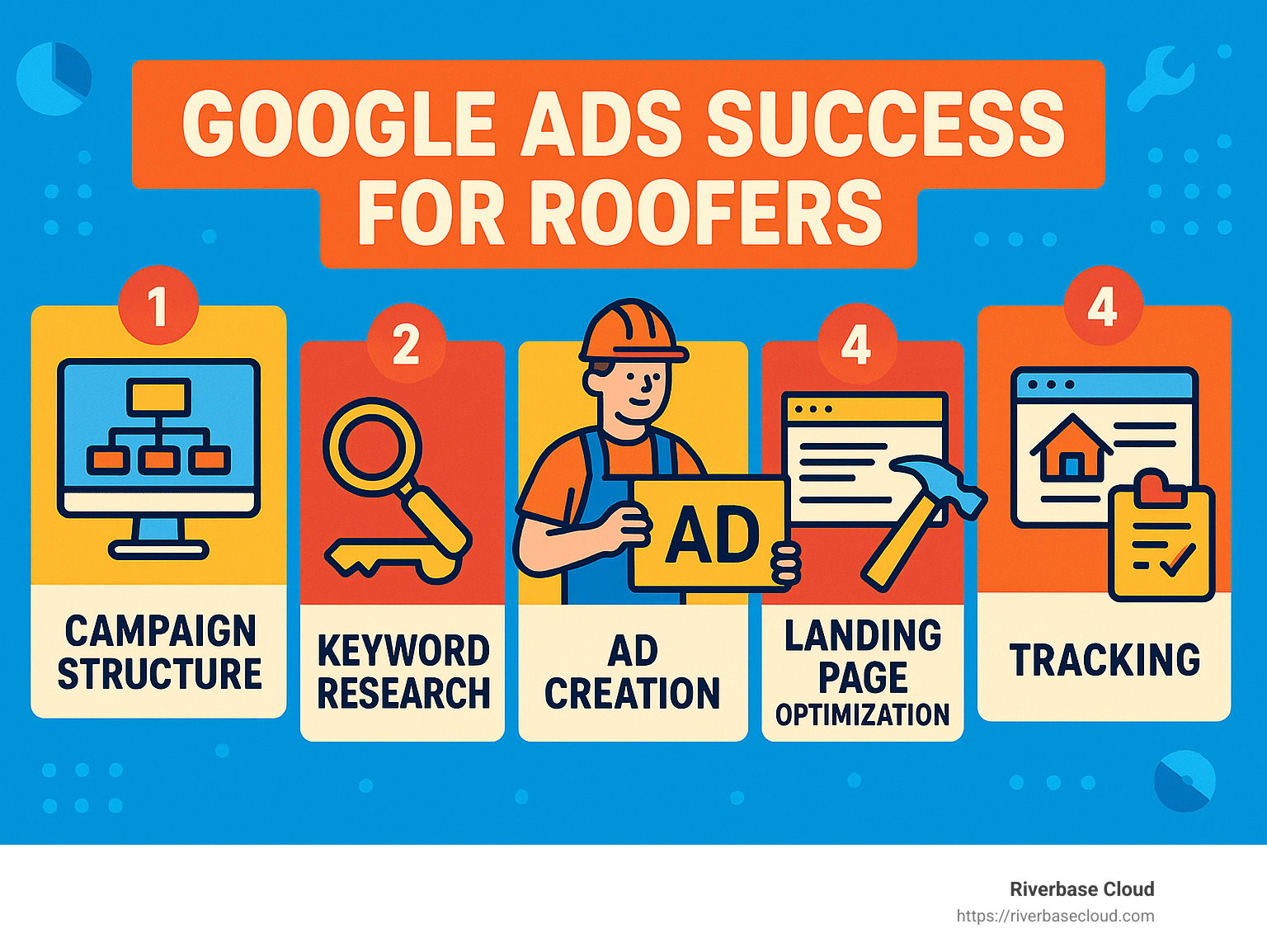
By following the strategies we've outlined in this guide, your roofing business can leverage the full power of Google Ads to consistently connect with homeowners who need your services—exactly when they're searching for a roofer they can trust. With a smart, well-managed approach to Google Ads for roofers, your business can confidently grow and thrive in the years ahead.
At Riverbase Cloud, we’re here to help your roofing business thrive in today’s competitive market. Ready to take the next step? Book a call with our team and find how the right mix of AI and expert guidance can drive your success.
